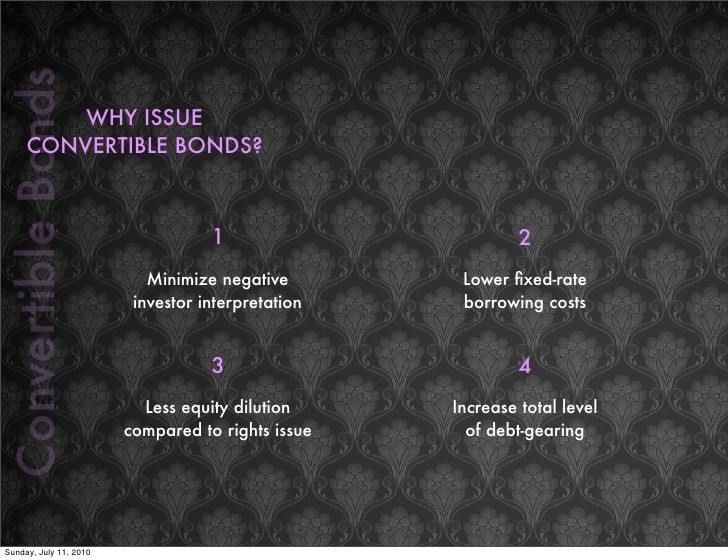Convertible Bonds_1
Post on: 25 Апрель, 2015 No Comment

A convertible bond is one which is convertible into the company’s common stock. The conversion option to the bond is exerciseable when and if the investor wants to do it. The conversion ratio varies from bond to bond. The terms of conversion are set forth in the indenture. The exact number of shares or the method of determining how many shares the bond is converted into is printed in the indenture.
Many times the indenture will tell you how many shares of stock the bond is convertible into. For instance, it might say that it is convertible into 20 shares. Therefore, the conversion ratio is 20:1. Unfortunately, it’s not always that easy. For instance, the indenture might state the conversion price. The conversion price is the price per share that the company is willing to trade their shares of stock for the bond. For example, if the indenture states that the conversion price is $50 per share, the bond is convertible into 20 shares of stock. You divide the par value (usually $1,000 for corporate bonds) by the conversion price. Occasionally, the indenture might state that the conversion ratio will change through the years. For example, the conversion price might be $50 for the first five years, $55 for the next five years, and so forth. There are also anti-dilutive features to the conversion feature. If the stock were to split 2 for 1, and the conversion ratio was 20 to 1 prior to the split, after the split, the conversion ratio would be 40 to 1. A stock dividend would also have the same effect. A stock split would also reduce the conversion price.
Because convertible bonds have a little something extra, the right to convert to common stock, that little something extra costs the bond holder. The bond will usually carry a slightly lower interest rate. If the stock price rises, the bond price will also rise. Since most convertible bonds are also callable, the company can force the bond holders to convert the bonds to common stock by calling the bonds. This is known as ‘Forced Conversion’. When a bond is converted to common stock, the corporate debt is reduced. What was formerly debt has now been converted to equity. Of course, converting debt (bonds) into stock (equity) has the effect of diluting the equity. The company didn’t get any larger with the additional stock. But each stockholder’s piece of the pie got smaller. If the company’s stock declines to a price which makes the convertible feature of the bond worthless, as long as the company is solvent, the bond will trade based on its yield — like any other bond. There is a price level to which a bond will fall and fall no further as long as the company can pay its interest and the principal upon maturity.














